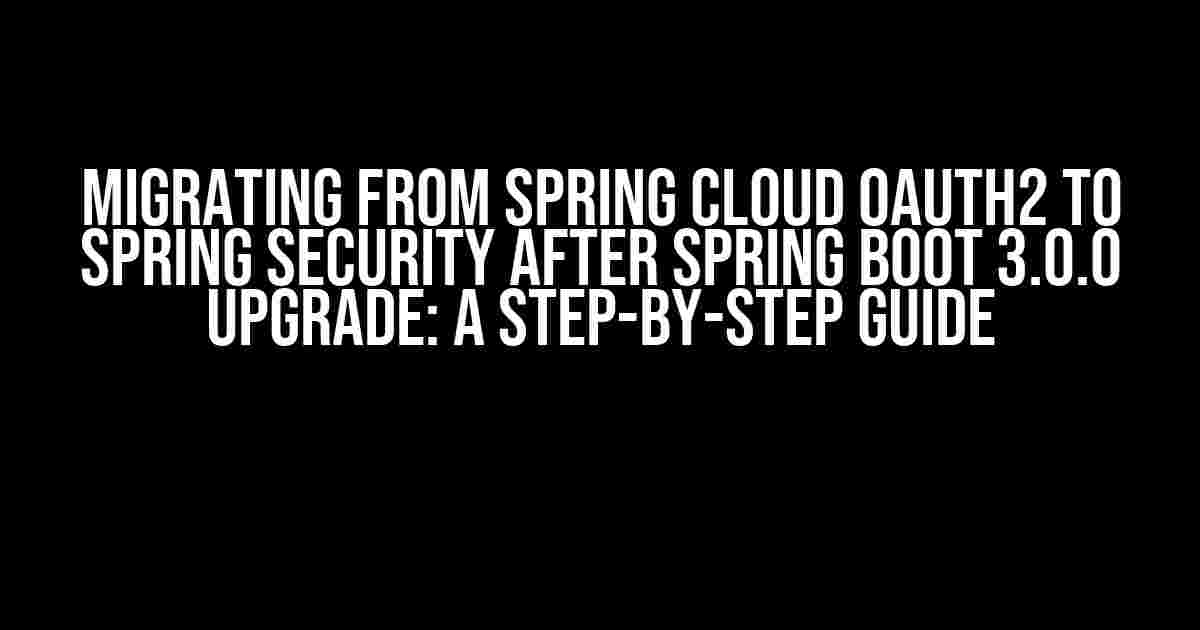Upgrading to Spring Boot 3.0.0 can be a daunting task, especially when it comes to security. With the deprecation of Spring Cloud OAuth2, many developers are left wondering how to migrate to the new Spring Security framework. Fear not, dear reader, for this article is here to guide you through the process with ease.
Why Migrate to Spring Security?
Before we dive into the nitty-gritty of the migration process, let’s take a step back and understand why you should migrate to Spring Security in the first place. With the release of Spring Boot 3.0.0, the Spring Cloud OAuth2 module has been deprecated, and support for it has been dropped. This means that if you want to take advantage of the latest features and security patches, you need to migrate to Spring Security.
Spring Security is a more comprehensive and flexible security framework that provides a wide range of features and configurations out of the box. It’s also more actively maintained and supported by the Spring team, ensuring that you get the best possible security for your application.
Preparing for the Migration
Before you start the migration process, make sure you have the following dependencies in your project’s pom.xml file (if you’re using Maven) or your build.gradle file (if you’re using Gradle):
<dependencies>
<dependency>
<groupId>org.springframework.boot</groupId>
<artifactId>spring-boot-starter-security</artifactId>
</dependency>
<dependency>
<groupId>org.springframework.boot</groupId>
<artifactId>spring-boot-starter-web</artifactId>
</dependency>
</dependencies>
Or, if you’re using Gradle:
dependencies {
implementation 'org.springframework.boot:spring-boot-starter-security'
implementation 'org.springframework.boot:spring-boot-starter-web'
}
Migrating OAuth2 Configuration
One of the most significant changes in the migration process is the replacement of OAuth2 configuration with Spring Security’s built-in configuration. You’ll need to remove the following configuration from your application:
@Configuration
@EnableOAuth2Sso
public class OAuth2Config extends WebSecurityConfigurerAdapter {
// ...
}
Instead, you’ll need to configure Spring Security using the SecurityConfig class. Here’s an example configuration:
@Configuration
public class SecurityConfig extends WebSecurityConfigurerAdapter {
@Override
protected void configure(HttpSecurity http) throws Exception {
http.oauth2Login();
}
}
Note that this is just a basic example, and you may need to add additional configurations depending on your application’s requirements.
Migrating OAuth2 Authentication
Another significant change is the replacement of OAuth2 authentication with Spring Security’s built-in authentication mechanism. You’ll need to update your authentication logic to use Spring Security’s AuthenticationManager interface.
Here’s an example of how to authenticate a user using Spring Security:
@PostMapping("/login")
public ResponseEntity<String> login(@RequestBody AuthenticationRequest authenticationRequest) {
Authentication authentication = new UsernamePasswordAuthenticationToken(authenticationRequest.getUsername(), authenticationRequest.getPassword());
Authentication result = authenticationManager.authenticate(authentication);
// ...
}
Make sure to inject the AuthenticationManager bean into your controller or service class:
@Autowired private AuthenticationManager authenticationManager;
Migrating OAuth2 Token Management
In Spring Cloud OAuth2, token management was handled by the OAuth2AuthorizationServerConfiguration class. In Spring Security, token management is handled by the DefaultTokenServices class.
Here’s an example of how to configure token services:
@Bean
public TokenStore tokenStore() {
return new InMemoryTokenStore();
}
@Bean
public DefaultTokenServices tokenServices() {
DefaultTokenServices tokenServices = new DefaultTokenServices();
tokenServices.setTokenStore(tokenStore());
return tokenServices;
}
You can then inject the TokenServices bean into your controller or service class to manage tokens:
@Autowired private TokenServices tokenServices;
Migrating OAuth2 Resource Server
In Spring Cloud OAuth2, resource servers were configured using the ResourceServerConfiguration class. In Spring Security, resource servers are configured using the OAuth2ResourceServerConfigurer interface.
Here’s an example of how to configure a resource server:
@Configuration
public class ResourceServerConfig implements OAuth2ResourceServerConfigurer {
@Override
public void configure(ResourceServerSecurityConfigurer resources) throws Exception {
resources.resourceId("my-resource-server");
}
}
Make sure to add the @EnableResourceServer annotation to your application configuration class:
@SpringBootApplication
@EnableResourceServer
public class MyApplication {
// ...
}
Common Migration Issues
Here are some common issues you may encounter during the migration process:
- OAuth2 authentication not working: Make sure you’ve updated your authentication logic to use Spring Security’s
AuthenticationManagerinterface. - Token management not working: Ensure that you’ve configured token services using the
DefaultTokenServicesclass. - Resource server not working: Verify that you’ve configured the resource server using the
OAuth2ResourceServerConfigurerinterface and added the@EnableResourceServerannotation to your application configuration class.
Conclusion
Migrating from Spring Cloud OAuth2 to Spring Security after a Spring Boot 3.0.0 upgrade can be a complex process, but with these step-by-step instructions, you should be able to navigate it with ease. Remember to update your OAuth2 configuration, authentication logic, token management, and resource server configuration to use Spring Security’s built-in features.
By following this guide, you’ll be able to take advantage of the latest security features and patches provided by Spring Boot 3.0.0 and ensure the security of your application.
| Feature | Spring Cloud OAuth2 | Spring Security |
|---|---|---|
| OAuth2 Configuration | @EnableOAuth2Sso annotation |
SecurityConfig class |
| Authentication | OAuth2AuthenticationManager interface |
AuthenticationManager interface |
| Token Management | OAuth2AuthorizationServerConfiguration class |
DefaultTokenServices class |
| Resource Server | ResourceServerConfiguration class |
OAuth2ResourceServerConfigurer interface |
By following this comprehensive guide, you’ll be able to successfully migrate from Spring Cloud OAuth2 to Spring Security after a Spring Boot 3.0.0 upgrade.
Frequently Asked Questions
Are you puzzled about migrating from Spring Cloud OAuth2 to Spring Security after upgrading to Spring Boot 3.0.0? Worry not! We’ve got you covered with these frequently asked questions.
What changes do I need to make to my OAuth2 configuration after upgrading to Spring Boot 3.0.0?
After upgrading to Spring Boot 3.0.0, you’ll need to migrate from Spring Cloud OAuth2 to Spring Security. This means replacing `@EnableOAuth2Client` with `@EnableWebSecurity` and updating your OAuth2 configuration to use Spring Security’s built-in OAuth2 support. Additionally, you’ll need to remove any Spring Cloud OAuth2 dependencies from your project.
How do I handle token validation and revocation with Spring Security?
With Spring Security, you can use the `OAuth2TokenValidator` and `OAuth2TokenRevocationService` beans to validate and revoke tokens. You’ll need to configure these beans in your application configuration and use them in your token validation and revocation logic. Spring Security also provides built-in support for token blacklisting and whitelisting.
What about my existing OAuth2 client registrations? Do I need to migrate those too?
Yes, you’ll need to migrate your existing OAuth2 client registrations to Spring Security’s `OAuth2AuthorizedGrantTypes` and `OAuth2AuthorizationGrants` beans. This will involve updating your client registration configurations to use the new Spring Security APIs. Don’t worry, it’s a relatively straightforward process!
Can I still use my custom OAuth2 token stores with Spring Security?
Absolutely! Spring Security provides support for custom token stores through its `OAuth2TokenStore` interface. You can implement your own token store using this interface and configure it in your application. This allows you to keep using your existing custom token stores with minimal changes.
What if I encounter issues during the migration process? Where can I get help?
Don’t panic! If you encounter any issues during the migration process, you can reach out to the Spring community for help. Check out the official Spring documentation, Spring Boot issue tracker, and Stack Overflow for answers to common problems. You can also seek help from online forums and communities dedicated to Spring development.


